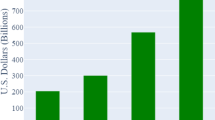Abstract
Subsidy and social systems should be designed to effectively promote, for example, the introduction of a mechanical system. For an effective subsidy distribution, developing evidence-based decision-making methodologies is essential. We developed a tool that minimizes an objective function includes economic costs, environmental cost, and disaster risk to determine the amount of energy distributed by the equipment when installing in hospitals against disasters. Open data available on the Internet are used as simulation values herein. This simulation model optimizes six design values using a genetic algorithm based on the values (business site area, demand for heat and electricity, and maximum allowable loss) input by customers for their construction and visualizes the total cost. The tool allows to quantitatively assess the changes in the initial and running costs owing to equipment installation and the avoidable losses related to \(\hbox {CO}_{2}\) emission reductions and disaster risks. In addition, the net present value (NPV) can be calculated using the obtained values for initial and running costs, thereby allowing to clearly estimate the return on investments after equipment installation. The opportunity profit can be calculated based on the difference between the NPV after 15 years assuming no risk and with disaster risks. A method to set this opportunity profit as a calculated subsidy amount is proposed herein. Decision support can be provided via these simulations to the customers and government subsidy system design engineers.







Similar content being viewed by others
Notes
SciREX, http://scirex.grips.ac.jp/en/ (accessed 4 December 2017).
Ministry of Health, Labor and Welfare (2017) Emergency strengthening notice for disaster hospital hospitals (in Japanese).
Bureau of Social Welfare and Public Health (2017) Tokyo Metropolitan Government. http://www.fukushihoken.metro.tokyo.jp/iryo/kyuukyuu/saigai/kyotenbyouinlist.html. Accessed 4 December 2017.
Tokyo Electric Power Company (2016) Database of TEPCO. http://www.tepco.co.jp/corporateinfo/illustrated/electricity-supply/forced-outages-minutes-j.html. Accessed 16 April 2007.
Hearing investigation to Tokyo Gas Co. Ltd. 2015.
Japan Seismic Hazard Information Station (2016) http://www.j-shis.bosai.go.jp/ Accessed 16 April 2007
Portal site of an earthquake J-JIS (2016) http://j-jis.com/news/shuto/tokyo/about.html. Accessed 16 April 2007.
Hearing investigation to Tokyo Gas Co. Ltd. 2015.
References
Akiyoshi T (2017) Introductory public policy studies—new knowledge to solve social problems. CHUOKORON-SHINSHA, INC., Tokyo (in Japanese)
Bogenschneider K, Corbett TJ (2010) Evidence-based policymaking: insights from policy-minded researchers and research-minded policymakers. Taylor & Francis Group, New York
Ito K, Ida T, Tanaka M (2015) The persistence of moral suasion and economic incentives. RIETI Discussion Paper Series 15-E-014
Japan Hospital Association (2013) Summary of analysis and inquiry of actual conditions for hospital management, H28FY (in Japanese)
The Japan Institute of Energy (2008) Cogeneration plan and design manual. Nippon Kogyo Shuppan, Tokyo (in Japanese)
Kuzuki R, Murakami S, Ikaga T, Yamada K, Kawayoke T, Ikuta Y, Komiyama T (2015) Study on business scheme of a community-level decentralized and self-reliant energy network. J Environ Eng (Japan) 80:169–176
Nagao H, Uemichi A, Yamasaki Y, Kaneko S (2017a) Proposal of a decision scheme for installing a cogeneration system considering disaster risks. Appl Therm Eng 114:1414–1423
Nagao H, Uemichi A, Yamasaki Y, Kaneko S, Bando S (2017b) Proposal of an optimization method for installing co-generation equipment considering business continuity planning under disaster cases. J Japan Soc Energy and Resources 38 (in Japanese)
NEDO (2013) R&D roadmap for secondary battery 2013 (in Japanese)
NEDO (2014) NEDO technical paper of renewable energy, 2nd edn. Morikita Shuppan (in Japanese)
NEDO (2017) METPV-11. http://www.stat.go.jp/data/nenkan/01.html \(\underline{.}\) Accessed 23 June 2017
Acknowledgements
This work is supported by the Siebel Energy Institute Research Grant 2017 and JST RISTEX.
Author information
Authors and Affiliations
Corresponding author
Rights and permissions
About this article
Cite this article
Uemichi, A., Yagi, M., Oikawa, R. et al. System design to reduce disaster risks by installing distributed power resources. Multiscale and Multidiscip. Model. Exp. and Des. 1, 49–56 (2018). https://doi.org/10.1007/s41939-017-0005-5
Received:
Accepted:
Published:
Issue Date:
DOI: https://doi.org/10.1007/s41939-017-0005-5




